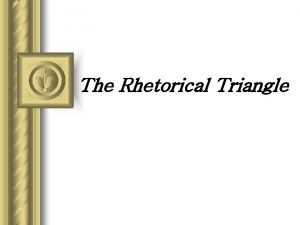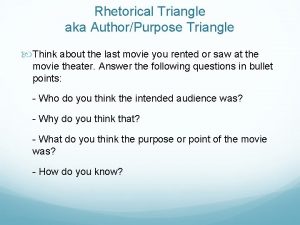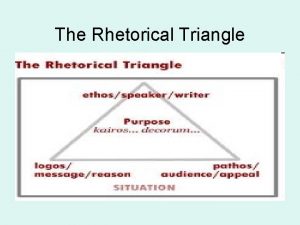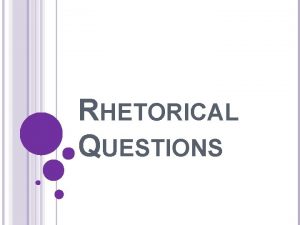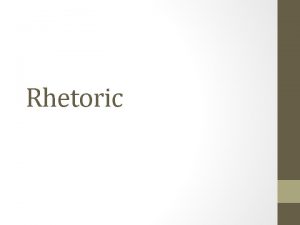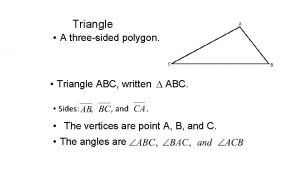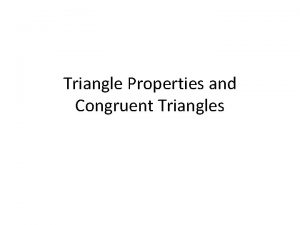An Introduction To the Rhetorical Triangle and Rhetorical






























- Slides: 30

An Introduction To the Rhetorical Triangle and Rhetorical Appeals

Part 1 - Introduction

Rhetorical Principles • Introduce you to the skills of critical thinking, reading, and writing. • Help you define and assess the rhetorical situation in which a certain argument is made. • Teach you to understand critically evaluate the arguments presented in various sources to which you refer. • Provide guidance as to how to create an effective argument in your own writing.

Definitions: Rhetoric “Rhetoric is the art of dressing up some unimportant matter so as to fool the audience for the time being. ” Ezra Pound How do you understand this definition of rhetoric? Do you agree with it? Why (not)?

Definitions: rhetoric/text • What is rhetoric? • Are these examples of rhetoric? Why (not)?

What other examples of a rhetoric can you think of? • • Web pages Posters Bumper stickers Television/movies Architecture Vehicles/industrial design Art/Sculpture

Rhetorical Triangle • Chose any text and answer the following questions: - Who created this piece of writing? - Who did they create this text for? - Why did they create this text? Speaker Audience Purpose/Message

Rhetorical Triangle: Author/Speaker • What do we know about the writer, speaker, artist, designer, or creator? – educational background – political affiliations – investment in message – biases • Where do we look for information about the author?

Rhetorical Triangle: Audience • Audience – who is the message intended for? – Age, gender, social/cultural group, political affiliation, etc… • Where do we look for information about the audience?

Rhetorical Triangle: Purpose (message) • What is the purpose of your text? – To inform? – To entertain? – To call to action? • How can you infer the purpose of the text? • What elements of the text do you refer to in order to find information about its purpose? • Message?

SOAPS + G


Part 2 – Rhetorical Appeals How does the writer APPEAL to the audience? How does the writer PERSUADE the audience?

ETHOS PATHOS LOGOS

The Rhetorical Appeals: Ethos • Ethos- Credibility - Ethics - Trustworthiness of the speaker/writer • Credibility based on audience’s view of author and subject • For Academic Argument, an author must: - Exhibit good sense - Demonstrate high moral character - Express good will

The Rhetorical Appeals: Logos • Logos - Logic – Attempt to appeal to the intellect – Everyday arguments vs. academic arguments – Common ways to appeal to logos? • Most valued appeal in academic argument • Accomplished through inductive or deductive reasoning – Definition – Evidence from other sources – Expert testimony

The Rhetorical Appeals: Pathos • Pathos – Pathetic, sympathy, empathy – – Appeal to emotions Arguments in popular press Manipulative Effect • Appeals to emotion are accomplished through – Sensory description – Value-laden diction – Anecdotes – Objects of emotions • People • Abstract concepts • Etc.



Part 3 – Triangle AND Appeals

Putting It All Together • How do the rhetorical triangle and rhetorical appeals work together to create a message? • These tools are not exclusive; all six should be considered when evaluating a text Speaker Ethos Pathos Audience Purpose Logos




Tips For Your Writing… • How can you apply rhetorical principles to your own writing? Think about… – Yourself as the author/speaker – Your audience – The purpose of your message and how you will achieve it

Author: How you want to appear to your audience • What impression do you want to make on your readers? • How will you show that you are worth trusting? • How will you demonstrate that you are an authority on your subject? • What do you have in common with your audience in order to create a bond with them?

Audience: What you should know about your readers • How much do they already know about your subject? • What do they expect to see in the document (style, format, organization)? • What preconceptions might they have about your subject? • What do they need to know? • What are their interests?

Purpose: What are you trying to achieve by writing? • Purpose – to persuade, sell, inform, entertain, express yourself, etc… • How are you going to achieve this goal? – What argument structure will you use (e. g. , spatial, chronological, comparison/contrast, etc. )? – What types of support will you include in your writing (e. g. , anecdotes, graphs, numbers, personal stories, quotes, facts, expert opinions, etc. )? – What types of language will you use (e. g. , denotative language, connotative language)


How do we reconcile the terminology of the rhetorical triangle and appeals with the terminology of our textbook?
 Triangle.of.calot
Triangle.of.calot Rhetorical triangle subject
Rhetorical triangle subject Ap lang rhetorical triangle
Ap lang rhetorical triangle Rhetorical triangle definition
Rhetorical triangle definition Rhetorical triangle speaker audience message
Rhetorical triangle speaker audience message Logos ethos pathos triangle
Logos ethos pathos triangle Logos ethos pathos triangle
Logos ethos pathos triangle Rhetorical triangle speaker audience message
Rhetorical triangle speaker audience message Hát kết hợp bộ gõ cơ thể
Hát kết hợp bộ gõ cơ thể Frameset trong html5
Frameset trong html5 Bổ thể
Bổ thể Tỉ lệ cơ thể trẻ em
Tỉ lệ cơ thể trẻ em Chó sói
Chó sói Glasgow thang điểm
Glasgow thang điểm Chúa yêu trần thế
Chúa yêu trần thế Môn thể thao bắt đầu bằng từ đua
Môn thể thao bắt đầu bằng từ đua Thế nào là hệ số cao nhất
Thế nào là hệ số cao nhất Các châu lục và đại dương trên thế giới
Các châu lục và đại dương trên thế giới Công thức tính độ biến thiên đông lượng
Công thức tính độ biến thiên đông lượng Trời xanh đây là của chúng ta thể thơ
Trời xanh đây là của chúng ta thể thơ Mật thư tọa độ 5x5
Mật thư tọa độ 5x5 Phép trừ bù
Phép trừ bù độ dài liên kết
độ dài liên kết Các châu lục và đại dương trên thế giới
Các châu lục và đại dương trên thế giới Thơ thất ngôn tứ tuyệt đường luật
Thơ thất ngôn tứ tuyệt đường luật Quá trình desamine hóa có thể tạo ra
Quá trình desamine hóa có thể tạo ra Một số thể thơ truyền thống
Một số thể thơ truyền thống Cái miệng xinh xinh thế chỉ nói điều hay thôi
Cái miệng xinh xinh thế chỉ nói điều hay thôi Vẽ hình chiếu vuông góc của vật thể sau
Vẽ hình chiếu vuông góc của vật thể sau Biện pháp chống mỏi cơ
Biện pháp chống mỏi cơ đặc điểm cơ thể của người tối cổ
đặc điểm cơ thể của người tối cổ







